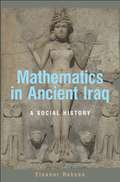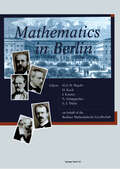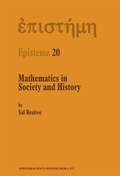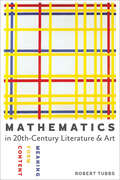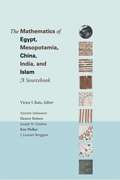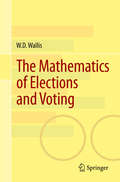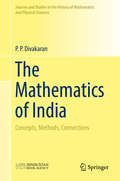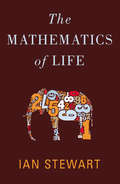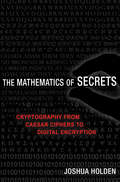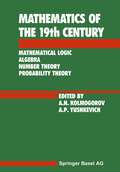- Table View
- List View
Mathematics in Ancient Iraq: A Social History
by Eleanor RobsonThis monumental book traces the origins and development of mathematics in the ancient Middle East, from its earliest beginnings in the fourth millennium BCE to the end of indigenous intellectual culture in the second century BCE when cuneiform writing was gradually abandoned. Eleanor Robson offers a history like no other, examining ancient mathematics within its broader social, political, economic, and religious contexts, and showing that mathematics was not just an abstract discipline for elites but a key component in ordering society and understanding the world. The region of modern-day Iraq is uniquely rich in evidence for ancient mathematics because its prehistoric inhabitants wrote on clay tablets, many hundreds of thousands of which have been archaeologically excavated, deciphered, and translated. Drawing from these and a wealth of other textual and archaeological evidence, Robson gives an extraordinarily detailed picture of how mathematical ideas and practices were conceived, used, and taught during this period. She challenges the prevailing view that they were merely the simplistic precursors of classical Greek mathematics, and explains how the prevailing view came to be. Robson reveals the true sophistication and beauty of ancient Middle Eastern mathematics as it evolved over three thousand years, from the earliest beginnings of recorded accounting to complex mathematical astronomy. Every chapter provides detailed information on sources, and the book includes an appendix on all mathematical cuneiform tablets published before 2007.
Mathematics in Berlin
by Heinrich Begehr Helmut Koch Jürg Kramer Norbert Schappacher Ernst-Jochen ThieleThis little book is conceived as a service to mathematicians attending the 1998 International Congress of Mathematicians in Berlin. It presents a comprehensive, condensed overview of mathematical activity in Berlin, from Leibniz almost to the present day (without, however, including biographies of living mathematicians). Since many towering figures in mathematical history worked in Berlin, most of the chapters of this book are concise biographies. These are held together by a few survey articles presenting the overall development of entire periods of scientific life at Berlin. Overlaps between various chapters and differences in style between the chap ters were inevitable, but sometimes this provided opportunities to show different aspects of a single historical event - for instance, the Kronecker-Weierstrass con troversy. The book aims at readability rather than scholarly completeness. There are no footnotes, only references to the individual bibliographies of each chapter. Still, we do hope that the texts brought together here, and written by the various authors for this volume, constitute a solid introduction to the history of Berlin mathematics.
Mathematics in Computing: An Accessible Guide to Historical, Foundational and Application Contexts (Undergraduate Topics in Computer Science)
by Gerard O’ReganThis illuminating textbook provides a concise review of the core concepts in mathematics essential to computer scientists. Emphasis is placed on the practical computing applications enabled by seemingly abstract mathematical ideas, presented within their historical context. The text spans a broad selection of key topics, ranging from the use of finite field theory to correct code and the role of number theory in cryptography, to the value of graph theory when modelling networks and the importance of formal methods for safety critical systems.This fully updated new edition has been expanded with a more comprehensive treatment of algorithms, logic, automata theory, model checking, software reliability and dependability, algebra, sequences and series, and mathematical induction.Topics and features: includes numerous pedagogical features, such as chapter-opening key topics, chapter introductions and summaries, review questions, and a glossary; describes the historical contributions of such prominent figures as Leibniz, Babbage, Boole, and von Neumann; introduces the fundamental mathematical concepts of sets, relations and functions, along with the basics of number theory, algebra, algorithms, and matrices; explores arithmetic and geometric sequences and series, mathematical induction and recursion, graph theory, computability and decidability, and automata theory; reviews the core issues of coding theory, language theory, software engineering, and software reliability, as well as formal methods and model checking; covers key topics on logic, from ancient Greek contributions to modern applications in AI, and discusses the nature of mathematical proof and theorem proving; presents a short introduction to probability and statistics, complex numbers and quaternions, and calculus.This engaging and easy-to-understand book will appeal to students of computer science wishing for an overview of the mathematics used in computing, and to mathematicians curious about how their subject is applied in the field of computer science. The book will also capture the interest of the motivated general reader.
Mathematics in Computing: An Accessible Guide to Historical, Foundational and Application Contexts
by Gerard O’ReganThis clearly written and enlightening textbook provides a concise, introductory guide to the key mathematical concepts and techniques used by computer scientists. Topics and features: ideal for self-study, offering many pedagogical features such as chapter-opening key topics, chapter introductions and summaries, review questions, and a glossary; places our current state of knowledge within the context of the contributions made by early civilizations, such as the ancient Babylonians, Egyptians and Greeks; examines the building blocks of mathematics, including sets, relations and functions; presents an introduction to logic, formal methods and software engineering; explains the fundamentals of number theory, and its application in cryptography; describes the basics of coding theory, language theory, and graph theory; discusses the concept of computability and decideability; includes concise coverage of calculus, probability and statistics, matrices, complex numbers and quaternions.
Mathematics in India
by Kim PlofkerBased on extensive research in Sanskrit sources, Mathematics in India chronicles the development of mathematical techniques and texts in South Asia from antiquity to the early modern period. Kim Plofker reexamines the few facts about Indian mathematics that have become common knowledge--such as the Indian origin of Arabic numerals--and she sets them in a larger textual and cultural framework. The book details aspects of the subject that have been largely passed over in the past, including the relationships between Indian mathematics and astronomy, and their cross-fertilizations with Islamic scientific traditions. Plofker shows that Indian mathematics appears not as a disconnected set of discoveries, but as a lively, diverse, yet strongly unified discipline, intimately linked to other Indian forms of learning. Far more than in other areas of the history of mathematics, the literature on Indian mathematics reveals huge discrepancies between what researchers generally agree on and what general readers pick up from popular ideas. This book explains with candor the chief controversies causing these discrepancies--both the flaws in many popular claims, and the uncertainties underlying many scholarly conclusions. Supplementing the main narrative are biographical resources for dozens of Indian mathematicians; a guide to key features of Sanskrit for the non-Indologist; and illustrations of manuscripts, inscriptions, and artifacts. Mathematics in India provides a rich and complex understanding of the Indian mathematical tradition. **Author's note: The concept of "computational positivism" in Indian mathematical science, mentioned on p. 120, is due to Prof. Roddam Narasimha and is explored in more detail in some of his works, including "The Indian half of Needham's question: some thoughts on axioms, models, algorithms, and computational positivism" (Interdisciplinary Science Reviews 28, 2003, 1-13).
Mathematics in India
by Kim PlofkerBased on extensive research in Sanskrit sources, Mathematics in India chronicles the development of mathematical techniques and texts in South Asia from antiquity to the early modern period. Kim Plofker reexamines the few facts about Indian mathematics that have become common knowledge--such as the Indian origin of Arabic numerals--and she sets them in a larger textual and cultural framework. The book details aspects of the subject that have been largely passed over in the past, including the relationships between Indian mathematics and astronomy, and their cross-fertilizations with Islamic scientific traditions. Plofker shows that Indian mathematics appears not as a disconnected set of discoveries, but as a lively, diverse, yet strongly unified discipline, intimately linked to other Indian forms of learning. Far more than in other areas of the history of mathematics, the literature on Indian mathematics reveals huge discrepancies between what researchers generally agree on and what general readers pick up from popular ideas. This book explains with candor the chief controversies causing these discrepancies--both the flaws in many popular claims, and the uncertainties underlying many scholarly conclusions. Supplementing the main narrative are biographical resources for dozens of Indian mathematicians; a guide to key features of Sanskrit for the non-Indologist; and illustrations of manuscripts, inscriptions, and artifacts. Mathematics in India provides a rich and complex understanding of the Indian mathematical tradition. **Author's note: The concept of "computational positivism" in Indian mathematical science, mentioned on p. 120, is due to Prof. Roddam Narasimha and is explored in more detail in some of his works, including "The Indian half of Needham's question: some thoughts on axioms, models, algorithms, and computational positivism" (Interdisciplinary Science Reviews 28, 2003, 1-13).
Mathematics in Society and History: Sociological Inquiries (Episteme #20)
by S. RestivoThis is the first book by a sociologist devoted exclusively to a general sociology of mathematics. The author provides examples of different ways of thinking about mathematics sociologically. The survey of mathematical traditions covers ancient China, the Arabic-Islamic world, India, and Europe. Following the leads of classical social theorists such as Emile Durkheim, Restivo develops the idea that mathematical concepts and ideas are collective representations, and that it is mathematical communities that create mathematics, not individual mathematicians. The implications of the sociology of mathematics, and especially of pure mathematics, for a sociology of mind are also explored. In general, the author's objective is to explore, conjecture, suggest, and stimulate in order to introduce the sociological perspective on mathematics, and to broaden and deepen the still narrow, shallow path that today carries the sociology of mathematics. This book will interest specialists in the philosophy, history, and sociology of mathematics, persons interested in mathematics education, students of science and society, and people interested in current developments in the social and cultural analysis of science and mathematics.
Mathematics in Twentieth-Century Literature and Art: Content, Form, Meaning
by Robert TubbsDuring the twentieth century, many artists and writers turned to abstract mathematical ideas to help them realize their aesthetic ambitions. Man Ray, Marcel Duchamp, and, perhaps most famously, Piet Mondrian used principles of mathematics in their work. Was it mere coincidence, or were these artists simply following their instincts, which in turn were ruled by mathematical underpinnings, such as optimal solutions for filling a space? If math exists within visual art, can it be found within literary pursuits? In short, just what is the relationship between mathematics and the creative arts?In this provocative, original exploration of mathematical ideas in art and literature, Robert Tubbs argues that the links are much stronger than previously imagined and exceed both coincidence and commonality of purpose. Not only does he argue that mathematical ideas guided the aesthetic visions of many twentieth-century artists and writers, Tubbs further asserts that artists and writers used math in their creative processes even though they seemed to have no affinity for mathematical thinking. In the end, Tubbs makes the case that art can be better appreciated when the math that inspired it is better understood. An insightful tour of the great masters of the last century and an argument that challenges long-held paradigms, Mathematics in Twentieth-Century Literature and Art will appeal to mathematicians, humanists, and artists, as well as instructors teaching the connections among math, literature, and art.
Mathematics in Victorian Britain
by Foreword by Dr Adam Hart-Davis, Writer, photographer and broadcasterDuring the Victorian era, industrial and economic growth led to a phenomenal rise in productivity and invention. That spirit of creativity and ingenuity was reflected in the massive expansion in scope and complexity of many scientific disciplines during this time, with subjects evolving rapidly and the creation of many new disciplines. The subject of mathematics was no exception and many of the advances made by mathematicians during the Victorian period are still familiar today; matrices, vectors, Boolean algebra, histograms, and standard deviation were just some of the innovations pioneered by these mathematicians. This book constitutes perhaps the first general survey of the mathematics of the Victorian period. It assembles in a single source research on the history of Victorian mathematics that would otherwise be out of the reach of the general reader. It charts the growth and institutional development of mathematics as a profession through the course of the 19th century in England, Scotland, Ireland, and across the British Empire. It then focuses on developments in specific mathematical areas, with chapters ranging from developments in pure mathematical topics (such as geometry, algebra, and logic) to Victorian work in the applied side of the subject (including statistics, calculating machines, and astronomy). Along the way, we encounter a host of mathematical scholars, some very well known (such as Charles Babbage, James Clerk Maxwell, Florence Nightingale, and Lewis Carroll), others largely forgotten, but who all contributed to the development of Victorian mathematics.
Mathematics in Western Culture
by Morris KlineThis book gives a remarkably fine account of the influences mathematics has exerted on the development of philosophy, the physical sciences, religion, and the arts in Western life.
Mathematics, Logic, and their Philosophies: Essays in Honour of Mohammad Ardeshir (Logic, Epistemology, and the Unity of Science #49)
by Shahid Rahman Mojtaba Mojtahedi Mohammad Saleh ZarepourThis volume is a collection of essays in honour of Professor Mohammad Ardeshir. It examines topics which, in one way or another, are connected to the various aspects of his multidisciplinary research interests. Based on this criterion, the book is divided into three general categories. The first category includes papers on non-classical logics, including intuitionistic logic, constructive logic, basic logic, and substructural logic. The second category is made up of papers discussing issues in the contemporary philosophy of mathematics and logic. The third category contains papers on Avicenna’s logic and philosophy.Mohammad Ardeshir is a full professor of mathematical logic at the Department of Mathematical Sciences, Sharif University of Technology, Tehran, Iran, where he has taught generations of students for around a quarter century. Mohammad Ardeshir is known in the first place for his prominent works in basic logic and constructive mathematics. His areas of interest are however much broader and include topics in intuitionistic philosophy of mathematics and Arabic philosophy of logic and mathematics. In addition to numerous research articles in leading international journals, Ardeshir is the author of a highly praised Persian textbook in mathematical logic. Partly through his writings and translations, the school of mathematical intuitionism was introduced to the Iranian academic community.
The Mathematics of Egypt, Mesopotamia, China, India, and Islam: A Sourcebook
by Victor J. Katz Annette Imhausen Eleanor Robson Joseph Warren Dauben Kim Plofker J. Lennart BerggrenIn recent decades it has become obvious that mathematics has always been a worldwide activity. But this is the first book to provide a substantial collection of English translations of key mathematical texts from the five most important ancient and medieval non-Western mathematical cultures, and to put them into full historical and mathematical context. The Mathematics of Egypt, Mesopotamia, China, India, and Islam gives English readers a firsthand understanding and appreciation of these cultures' important contributions to world mathematics. The five section authors--Annette Imhausen (Egypt), Eleanor Robson (Mesopotamia), Joseph Dauben (China), Kim Plofker (India), and J. Lennart Berggren (Islam)--are experts in their fields. Each author has selected key texts and in many cases provided new translations. The authors have also written substantial section introductions that give an overview of each mathematical culture and explanatory notes that put each selection into context. This authoritative commentary allows readers to understand the sometimes unfamiliar mathematics of these civilizations and the purpose and significance of each text. Addressing a critical gap in the mathematics literature in English, this book is an essential resource for anyone with at least an undergraduate degree in mathematics who wants to learn about non-Western mathematical developments and how they helped shape and enrich world mathematics. The book is also an indispensable guide for mathematics teachers who want to use non-Western mathematical ideas in the classroom.
The Mathematics of Egypt, Mesopotamia, China, India, and Islam: A Sourcebook
by Kim Plofker Annette Imhausen Joseph Warren Dauben J. Lennart Berggren Eleanor RobsonIn recent decades it has become obvious that mathematics has always been a worldwide activity. But this is the first book to provide a substantial collection of English translations of key mathematical texts from the five most important ancient and medieval non-Western mathematical cultures, and to put them into full historical and mathematical context. The Mathematics of Egypt, Mesopotamia, China, India, and Islam gives English readers a firsthand understanding and appreciation of these cultures' important contributions to world mathematics. The five section authors--Annette Imhausen (Egypt), Eleanor Robson (Mesopotamia), Joseph Dauben (China), Kim Plofker (India), and J. Lennart Berggren (Islam)--are experts in their fields. Each author has selected key texts and in many cases provided new translations. The authors have also written substantial section introductions that give an overview of each mathematical culture and explanatory notes that put each selection into context. This authoritative commentary allows readers to understand the sometimes unfamiliar mathematics of these civilizations and the purpose and significance of each text. Addressing a critical gap in the mathematics literature in English, this book is an essential resource for anyone with at least an undergraduate degree in mathematics who wants to learn about non-Western mathematical developments and how they helped shape and enrich world mathematics. The book is also an indispensable guide for mathematics teachers who want to use non-Western mathematical ideas in the classroom.
The Mathematics of Elections and Voting
by W.D. WallisThis title takes an in-depth look at the mathematics in the context of voting and electoral systems, with focus on simple ballots, complex elections, fairness, approval voting, ties, fair and unfair voting, and manipulation techniques. The exposition opens with a sketch of the mathematics behind the various methods used in conducting elections. The reader is lead to a comprehensive picture of the theoretical background of mathematics and elections through an analysis of Condorcet’s Principle and Arrow’s Theorem of conditions in electoral fairness. Further detailed discussion of various related topics include: methods of manipulating the outcome of an election, amendments, and voting on small committees.In recent years, electoral theory has been introduced into lower-level mathematics courses, as a way to illustrate the role of mathematics in our everyday life. Few books have studied voting and elections from a more formal mathematical viewpoint. This text will be useful to those who teach lower level courses or special topics courses and aims to inspire students to understand the more advanced mathematics of the topic. The exercises in this text are ideal for upper undergraduate and early graduate students, as well as those with a keen interest in the mathematics behind voting and elections.
The Mathematics of Frobenius in Context: A Journey Through 18th to 20th Century Mathematics (Sources and Studies in the History of Mathematics and Physical Sciences)
by Thomas HawkinsFrobenius made many important contributions to mathematics in the latter part of the 19th century. Hawkins here focuses on his work in linear algebra and its relationship with the work of Burnside, Cartan, and Molien, and its extension by Schur and Brauer. He also discusses the Berlin school of mathematics and the guiding force of Weierstrass in that school, as well as the fundamental work of d'Alembert, Lagrange, and Laplace, and of Gauss, Eisenstein and Cayley that laid the groundwork for Frobenius's work in linear algebra. The book concludes with a discussion of Frobenius's contribution to the theory of stochastic matrices.
The Mathematics of India: Concepts, Methods, Connections (Sources and Studies in the History of Mathematics and Physical Sciences)
by P. P. DivakaranThis book identifies three of the exceptionally fruitful periods of the millennia-long history of the mathematical tradition of India: the very beginning of that tradition in the construction of the now-universal system of decimal numeration and of a framework for planar geometry; a classical period inaugurated by Aryabhata’s invention of trigonometry and his enunciation of the principles of discrete calculus as applied to trigonometric functions; and a final phase that produced, in the work of Madhava, a rigorous infinitesimal calculus of such functions. The main highlight of this book is a detailed examination of these critical phases and their interconnectedness, primarily in mathematical terms but also in relation to their intellectual, cultural and historical contexts.Recent decades have seen a renewal of interest in this history, as manifested in the publication of an increasing number of critical editions and translations of texts, as well as in an informed analytic interpretation of their content by the scholarly community. The result has been the emergence of a more accurate and balanced view of the subject, and the book has attempted to take an account of these nascent insights. As part of an endeavour to promote the new awareness, a special attention has been given to the presentation of proofs of all significant propositions in modern terminology and notation, either directly transcribed from the original texts or by collecting together material from several texts.
The Mathematics of Life: Unlocking The Secrets Of Existence
by Ian Stewart"Will this book do for biomathematics what Stephen Hawking's A Brief History of Time did for relativity and cosmology? Time will tell. Until then, the distinguished author's friendly, well-argued style should guarantee its popular success." --Times Higher Education Supplement (London)Biologists have long dismissed mathematics as being unable to meaningfully contribute to our understanding of living beings. Within the past ten years, however, mathematicians have proven that they hold the key to unlocking the mysteries of our world--and ourselves. In The Mathematics of Life, Ian Stewart provides a fascinating overview of the vital but little-recognized role mathematics has played in pulling back the curtain on the hidden complexities of the natural world--and how its contribution will be even more vital in the years ahead. In his characteristically clear and entertaining fashion, Stewart explains how mathematicians and biologists have come to work together on some of the most difficult scientific problems that the human race has ever tackled, including the nature and origin of life itself.
The Mathematics of Secrets: Cryptography from Caesar Ciphers to Digital Encryption
by Joshua HoldenThe Mathematics of Secrets takes readers on a fascinating tour of the mathematics behind cryptography—the science of sending secret messages. Most books about cryptography are organized historically, or around how codes and ciphers have been used, such as in government and military intelligence or bank transactions. Joshua Holden instead shows how mathematical principles underpin the ways that different codes and ciphers operate. Holden focuses on both code making and code breaking and he discusses the majority of ancient and modern ciphers currently known.Holden begins by looking at substitution ciphers, built by substituting one letter or block of letters for another. Explaining one of the simplest and historically well-known ciphers, the Caesar cipher, Holden establishes the key mathematical idea behind the cipher and discusses how to introduce flexibility and additional notation. Holden goes on to explore polyalphabetic substitution ciphers, transposition ciphers, including one developed by the Spartans, connections between ciphers and computer encryption, stream ciphers, and ciphers involving exponentiation. He also examines public-key ciphers, where the methods used to encrypt messages are public knowledge, and yet, intended recipients are still the only ones who are able to read the message. He concludes with a look at the future of ciphers and where cryptography might be headed. Only basic mathematics up to high school algebra is needed to understand and enjoy the book.With a plethora of historical anecdotes and real-world examples, The Mathematics of Secrets reveals the mathematics working stealthily in the science of coded messages.
The Mathematics of Secrets: Cryptography from Caesar Ciphers to Digital Encryption
by Joshua HoldenThe Mathematics of Secrets takes readers on a fascinating tour of the mathematics behind cryptography—the science of sending secret messages. Using a wide range of historical anecdotes and real-world examples, Joshua Holden shows how mathematical principles underpin the ways that different codes and ciphers work. He focuses on both code making and code breaking and discusses most of the ancient and modern ciphers that are currently known. He begins by looking at substitution ciphers, and then discusses how to introduce flexibility and additional notation. Holden goes on to explore polyalphabetic substitution ciphers, transposition ciphers, connections between ciphers and computer encryption, stream ciphers, public-key ciphers, and ciphers involving exponentiation. He concludes by looking at the future of ciphers and where cryptography might be headed. The Mathematics of Secrets reveals the mathematics working stealthily in the science of coded messages.A blog describing new developments and historical discoveries in cryptography related to the material in this book is accessible at http://press.princeton.edu/titles/10826.html.
Mathematics of the 19th Century: Geometry, Analytic Function Theory
by Andrei N. Kolmogorov Adolf-Andrei P. YushkevichThe general principles by which the editors and authors of the present edition have been guided were explained in the preface to the first volume of Mathemat ics of the 19th Century, which contains chapters on the history of mathematical logic, algebra, number theory, and probability theory (Nauka, Moscow 1978; En glish translation by Birkhiiuser Verlag, Basel-Boston-Berlin 1992). Circumstances beyond the control of the editors necessitated certain changes in the sequence of historical exposition of individual disciplines. The second volume contains two chapters: history of geometry and history of analytic function theory (including elliptic and Abelian functions); the size of the two chapters naturally entailed di viding them into sections. The history of differential and integral calculus, as well as computational mathematics, which we had planned to include in the second volume, will form part of the third volume. We remind our readers that the appendix of each volume contains a list of the most important literature and an index of names. The names of journals are given in abbreviated form and the volume and year of publication are indicated; if the actual year of publication differs from the nominal year, the latter is given in parentheses. The book History of Mathematics from Ancient Times to the Early Nineteenth Century [in Russian], which was published in the years 1970-1972, is cited in abbreviated form as HM (with volume and page number indicated). The first volume of the present series is cited as Bk. 1 (with page numbers).
Mathematics of the 19th Century: Mathematical Logic Algebra Number Theory Probability Theory
by KOLMOGOROV YUSHKEVICHThis multi-authored effort, Mathematics of the nineteenth century (to be fol lowed by Mathematics of the twentieth century), is a sequel to the History of mathematics fram antiquity to the early nineteenth century, published in three 1 volumes from 1970 to 1972. For reasons explained below, our discussion of twentieth-century mathematics ends with the 1930s. Our general objectives are identical with those stated in the preface to the three-volume edition, i. e. , we consider the development of mathematics not simply as the process of perfecting concepts and techniques for studying real-world spatial forms and quantitative relationships but as a social process as weIl. Mathematical structures, once established, are capable of a certain degree of autonomous development. In the final analysis, however, such immanent mathematical evolution is conditioned by practical activity and is either self-directed or, as is most often the case, is determined by the needs of society. Proceeding from this premise, we intend, first, to unravel the forces that shape mathe matical progress. We examine the interaction of mathematics with the social structure, technology, the natural sciences, and philosophy. Throughan anal ysis of mathematical history proper, we hope to delineate the relationships among the various mathematical disciplines and to evaluate mathematical achievements in the light of the current state and future prospects of the science. The difficulties confronting us considerably exceeded those encountered in preparing the three-volume edition.
The Mathematics of the Gods and the Algorithms of Men: A Cultural History
by Paolo ZelliniIs mathematics a discovery or an invention? Do numbers truly exist? What sort of reality do formulas describe?The complexity of mathematics - its abstract rules and obscure symbols - can seem very distant from the everyday. There are those things that are real and present, it is supposed, and then there are mathematical concepts: creations of our mind, mysterious tools for those unengaged with the world. Yet, from its most remote history and deepest purpose, mathematics has served not just as a way to understand and order, but also as a foundation for the reality it describes.In this elegant book, mathematician and philosopher Paolo Zellini offers a brief cultural and intellectual history of mathematics, ranging widely from the paradoxes of ancient Greece to the sacred altars of India, from Mesopotamian calculus to our own contemporary obsession with algorithms. Masterful and illuminating, The Mathematics of the Gods and the Algorithms of Men transforms our understanding of mathematical thinking, showing that it is inextricably linked with the philosophical and the religious as well as the mundane - and, indeed, with our own very human experience of the universe.
The Mathematics of the Heavens and the Earth: The Early History of Trigonometry
by Glen Van BrummelenThe Mathematics of the Heavens and the Earth is the first major history in English of the origins and early development of trigonometry. Glen Van Brummelen identifies the earliest known trigonometric precursors in ancient Egypt, Babylon, and Greece, and he examines the revolutionary discoveries of Hipparchus, the Greek astronomer believed to have been the first to make systematic use of trigonometry in the second century BC while studying the motions of the stars. The book traces trigonometry's development into a full-fledged mathematical discipline in India and Islam; explores its applications to such areas as geography and seafaring navigation in the European Middle Ages and Renaissance; and shows how trigonometry retained its ancient roots at the same time that it became an important part of the foundation of modern mathematics.The Mathematics of the Heavens and the Earth looks at the controversies as well, including disputes over whether Hipparchus was indeed the father of trigonometry, whether Indian trigonometry is original or derived from the Greeks, and the extent to which Western science is indebted to Islamic trigonometry and astronomy. The book also features extended excerpts of translations of original texts, and detailed yet accessible explanations of the mathematics in them. No other book on trigonometry offers the historical breadth, analytical depth, and coverage of non-Western mathematics that readers will find in The Mathematics of the Heavens and the Earth.
The Mathematics of the Modernist Villa: Architectural Analysis Using Space Syntax and Isovists (Mathematics and the Built Environment #3)
by Michael J. Ostwald Michael J. DawesThis book presents the first detailed mathematical analysis of the social, cognitive and experiential properties of Modernist domestic architecture.The Modern Movement in architecture, which came to prominence during the first half of the twentieth century, may have been famous for its functional forms and machine-made aesthetic, but it also sought to challenge the way people inhabit, understand and experience space. Ludwig Mies van der Rohe’s buildings were not only minimalist and transparent, they were designed to subvert traditional social hierarchies. Frank Lloyd Wright’s organic Modernism not only attempted to negotiate a more responsive relationship between nature and architecture, but also shape the way people experience space. Richard Neutra’s Californian Modernism is traditionally celebrated for its sleek, geometric forms, but his intention was to use design to support a heightened understanding of context. Glenn Murcutt’s pristine pavilions, seemingly the epitome of regional Modernism, actually raise important questions about the socio-spatial structure of architecture. Rather than focussing on form or style in Modernism, this book examines the spatial, social and experiential properties of thirty-seven designs by Wright, Mies, Neutra and Murcutt. The computational and mathematical methods used for this purpose are drawn from space syntax, isovist geometry and graph theory. The specific issues that are examined include: the sensory and emotional appeal of space and form; shifting social and spatial structures in architectural planning; wayfinding and visual understanding; and the relationship between form and program.
Mathematics of the Transcendental: Onto-logy And Being-there
by Alain BadiouIn Mathematics of the Transcendental, Alain Badiou painstakingly works through the pertinent aspects of Category Theory, demonstrating their internal logic and veracity, their derivation and distinction from Set Theory, and the 'thinking of being'. In doing so he sets out the basic onto-logical requirements of his greater and transcendental logics as articulated in his magnum opus, Logics of Worlds. This important book combines both his elaboration of the disjunctive synthesis between ontology and onto-logy (the discourses of being as such and being-appearing) from the perspective of Category Theory and the categorial basis of his philosophical conception of 'being there'. Hitherto unpublished in either French or English, Mathematics of the Transcendental provides Badiou's readers with a much-needed complete elaboration of his understanding and use of Category Theory. The book is an essential aid to understanding the mathematical and logical basis of his theory of appearing as elaborated in Logics of Worlds and other works and is essential reading for his many followers.
